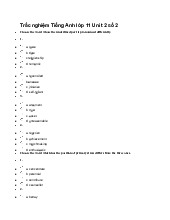



Preview text:
Giải Tiếng Anh 11 Unit 2: Reading Bài 1
Different generations (Những thế hệ khác nhau)
Work in pairs. Look at the photos. Discuss what you know about the generation
in each picture (e.g. age, characteristics, interests, life experiences).
(Làm việc theo cặp. Nhìn vào những bức ảnh. Thảo luận những gì bạn biết về thế hệ
trong mỗi bức tranh (ví dụ: tuổi tác, đặc điểm, sở thích, kinh nghiệm sống). Gợi ý đáp án
Generation X includes those born between 1965 and 1981, during the reconstruction
of Europe after the war. They are less dependent on smartphones than the next generations.
(Thế hệ X bao gồm những người sinh từ năm 1965 đến 1981, trong thời kỳ tái thiết
châu Âu sau chiến tranh. Họ ít phụ thuộc vào smartphone hơn các thế hệ tiếp theo.)
Generation Y is those born between 1982 and 1994 and technology is part of their
everyday lives: all their activities are mediated by a screen. However, the millennial
generation is labelled as being lazy, narcissistic and spoilt.
(Thế hệ Y là những người sinh từ năm 1982 đến 1994 và công nghệ là một phần trong
cuộc sống hàng ngày của họ: mọi hoạt động của họ đều được điều khiển bởi màn hình.
Tuy nhiên, thế hệ Y bị coi là lười biếng, tự ái và hư hỏng.)
Generation Z were born between1995 and 2010 — they arrived with a tablet and
a smartphone under their arms. It is a group of people that is marked by the
Internet. Their mastery of technologies may make them neglect their interpersonal
relationships to a greater extent, but they are the ones who give more of a voice to
social causes on the Internet.
(Thế hệ Z sinh năm 1995 đến 2010 - họ được cung cấp một chiếc máy tính bảng và
điện thoại thông minh. Đó là một nhóm người được đánh dấu bởi Internet. Sự thông
thạo công nghệ của họ có thể khiến họ bỏ bê các mối quan hệ giữa các cá nhân ở mức
độ lớn hơn, nhưng họ là những người đưa ra nhiều tiếng nói hơn cho các hoạt động
xã hội trên Internet.) Bài 2
Read the article. Match the highlighted words with their meanings.
(Đọc bài báo. Nối các từ được đánh dấu với nghĩa của chúng.) 1. experienced
a. to try or test new ideas or methods 2. curious b. went through 3. digital natives c. to employ 4. experiment
d. wanting to know about something 5. hire
e. people born in the era of technology Gợi ý đáp án 1 - b 2 - d 3 - e 4 - a 5 - c Bài 3
Read the article again and choose the best title.
(Đọc bài báo một lần nữa và chọn tiêu đề đúng nhất.)
A. The study of different generations
B. Generational differences in different societies
C. Characteristics of different generations Gợi ý đáp án
C. Characteristics of different generations
(Đặc điểm của các thế hệ khác nhau)
Thông tin:Each generation comes with its characteristics, which are largely
influenced by the historical, economic, and social conditions of the country they live in. Bài 4
Read the article again. Tick (✔) the characteristics of each generation according to the article.
(Đọc bài báo một lần nữa. Tick (✔) vào đặc điểm của mỗi thế hệ theo bài viết.)
Generation Generation Generation X Y Z
1. They enjoy working in a team with others.
2. They can use apps and digital devices in creative ways.
3. Critical thinking is one of their common characteristics.
4. Most of them plan to have their own businesses.
5. They are known for their curiosity. Gợi ý đáp án
Generation Generation Generation X Y Z
1. They enjoy working in a team with ✔ others.
2. They can use apps and digital devices in ✔ creative ways.
3. Critical thinking is one of their common ✔ characteristics.
4. Most of them plan to have their own ✔ businesses.
5. They are known for their curiosity. ✔ Bài 5
Work in groups. Discuss the following question.
Do you agree with the descriptions of each generation? Gợi ý đáp án
Yes, I do. The descriptions of each generation are accurate. Each trait is described in a
specific way and has compelling evidence. The characteristics of each generation are
clearly described, based on the development of the social sciences.




